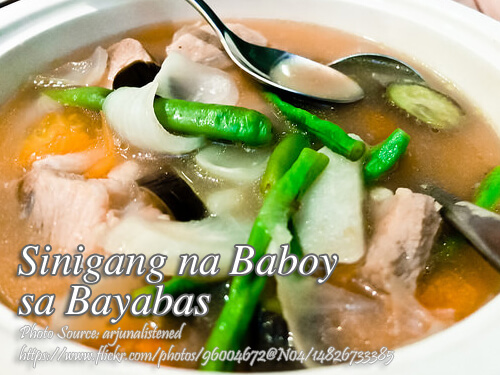How to Cook Sinigang na Baboy sa Bayabas
Sinigang na Baboy sa Bayabas is a Filipino sour soup featuring tender pork ribs in a broth infused with the delightful tang of guava, complemented by a colorful medley of vegetables.
Prep Time15 minutes mins
Cook Time40 minutes mins
Total Time55 minutes mins
Course: Pork Recipe
Cuisine: Filipino
Keyword: pork sinigang, sinigang na baboy, sinigang sa bayabas
Servings: 6 Servings
Calories: 494kcal
Author: Manny
- 1 kilo pork ribs chopped to serving pieces
- 2 pcs small eggplants slice diagonally
- 1 bunch kangkong remove from the stem
- 2 pcs tomatoes quartered
- 1 inch ginger slice into strips
- 1 Tbsp. patis or fish sauce
- 5 pcs okra sliced
- 2 cups sitaw or string beans sliced 1 1/2 inch
- 3 pcs small gabi or taro root peeled and quartered
- 3 pcs siling labuyo or bird's eye chili peppers
- 2 pcs small red onions sliced
- 1/2 kilo guavas quartered
- salt and pepper
How to cook Sinigang na Baboy sa Bayabas:
In a medium size stainless steel pot, boil some water slightly more than enough to cover the meat.
While the water is boiling, put the pork ribs one by one until every piece of meat is in the pot.
Then add the tomatoes and guavas and cook for about 30 to 40 minutes or until the meat is tender.
Add the onions, gabi, siling labuyo, ginger, salt and pepper then cook for another 8 minutes.
Then add the sitaw, okra and eggplants and simmer for another 6 minutes. Add in the kangkong and simmer for 1 minutes more. Serve hot.
Cooking Tips:
Choose the Right Guava for the Broth
For your sinigang, you can use guavas that are ripened but firm, balancing the sweetness with the tang in the broth. Overripe guavas turn mushy and overpower the flavor. Under-ripened ones would not give you that sweetness. Slice them thick enough that they can hold their shape while simmering.
Pork Toughened to Perfection
Simmer the meat with low to medium heat for at least 30 to 40 minutes to achieve a tender pork that falls apart in your mouth. Letting the pork boil too aggressively could toughen it rather than making it tender. Patience reaps the best reward from letting the broth and the meat cook together.
Add Vegetables at the Right Time
Different vegetables have different cooking times. Add the gabi first; the siling labuyo should also go in early, so it infuses into the broth completely, and then add kangkong later, so it is fresh and crunchy. You will never overcook your vegetables this way.
Nutrition Notes:
Calorie and other nutrition information is derived from HappyFolks.Com recipe nutrition calculator. The percent daily value (%DV) is based on a daily 2,000 calorie diet.
Nutrition Facts:
Amount per Serving:556g, Calories: 494kcal, From fat:149, Total fat:16.6g, Saturated Fat:5.2g, Trans Fat:0.1g, Cholesterol:111mg, Sodium:566mg Total Carbohydrate: 37g, Dietary Fiber: 12g, Sugars: 14g, Protein: 51g, Vitamin A: 135%, Vitamin C: 406%, Calcium: 17%, Iron: 23% 